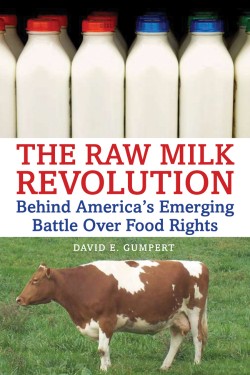The Raw Milk Revolution, by David E. Gumpert, would more accurately be entitled “Milk Wars.” Any attempt to sell raw milk creates a froth of such proportions that we must conclude that it is symptomatic of something bigger.
The Raw Milk Revolution, by David E. Gumpert, would more accurately be entitled “Milk Wars.” Any attempt to sell raw milk creates a froth of such proportions that we must conclude that it is symptomatic of something bigger.
The war is all about politics and ideology – about food control and food beliefs. So when battle lines are outwardly drawn around issues of food safety and the right of citizens to choose the food they want, it takes Gumpert’s sharp journalistic skills to uncover what risks to profits and livelihoods could lie beneath.
In most of the US, unpasteurized (raw) milk cannot be sold. The likelihood of contracting a food-borne illness is higher with raw milk, but farmers say the risk can be minimized with proper precautions. Nevertheless, regulators see any attempt to sell raw milk as the slippery slope to disaster, refusing in most states to entertain the option of licensing farmers to sell clean and inspected raw milk. Their microbiology-based arguments are countered by testimonials of people who claim that raw milk is the answer to various medical conditions.
It sets up a “science versus stories” dynamic that seems problematic. But why is there no published scientific literature on the potential health value of raw milk? Gumpert maintains that this one-sided focus from scientists could be a reflection of the depth of a manufactured taboo, which views all bacteria in negative terms. If regular exposure to small amounts of bacteria in milk could strengthen the immune system by creating healthy gut flora (as one theory goes), could this not be the legitimate subject of scientific investigation?
The book is a play-by-play documentation of dairy farms in California, Michigan and Iowa, where raw milk attracts thousands of consumers, but also the authorities. The reader will be shocked by accounts of military-style sting operations, in which dairy farmers are treated as terrorists, and their bottles of raw milk are confiscated as if they were explosive devices. But we are also sobered by the devastating illness caused by E. coli infection in some well-publicized cases, although the connection with raw milk is often assumed, not proven.
Why, asks Gumpert, is the government kicking around a bunch of small dairy farmers? Despite the fact that farmers can charge more for raw milk if they sell it directly than if it goes to the milk processing industry, Gumpert refuses to frame the battle solely as control by Big Dairy. He points to the dominant medical paradigm of disease in which bacteria are the enemy. The low legal benchmarks for bacteria in raw milk appear both unrealistic and unfair, and data from the Centre for Disease Control show that the risk of contracting listeriosis from deli meat could be greater than from raw milk.
Gumpert, in American-centred fashion, refers to “the government” and “our country” throughout the book without any acknowledgment that Canadians are fighting similar battles. For instance, Canadian courts recently charged, and then exonerated, Michael Schmidt for selling unpasteurized milk in Southern Ontario. In both countries, opposing groups have dug in for a protracted battle that shows no sign of ending anytime soon.
The Raw Milk Revolution: Behind America’s Emerging Battle Over Food Rights, David E. Gumpert, White River Junction, Vermont: Chelsea Green Publishing, 2009, 288 pages
This review originally appeared in New Eco Books, Issue 36.3. Subscribe now to get more book reviews in your mailbox!
Reviewer Information
Co-chair of the Waterloo Region Food Systems Roundtable, Ellen Desjardins writes extensively about food security issues. Her current research explores how people respond to a changing food environment.













